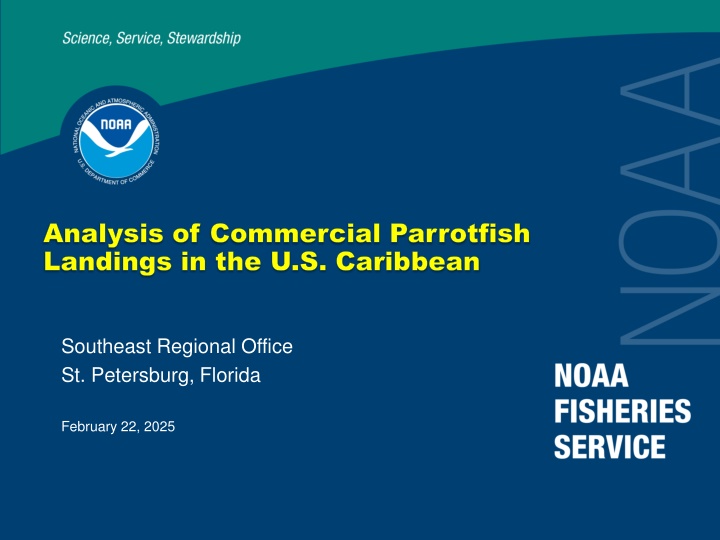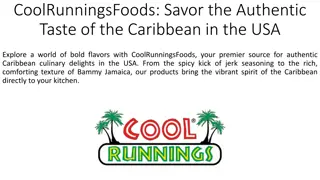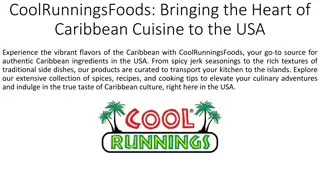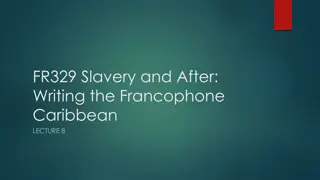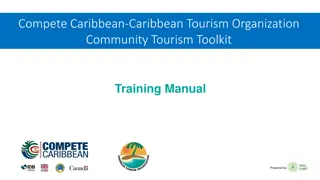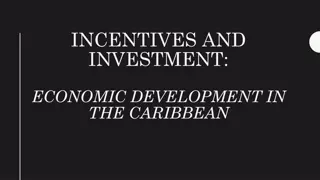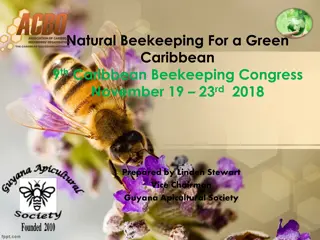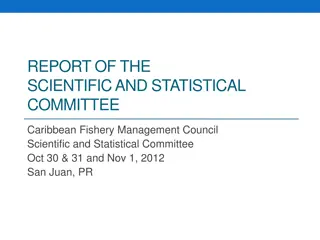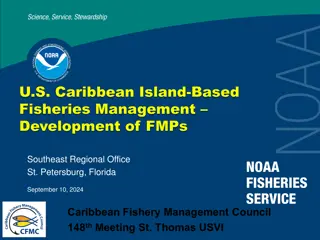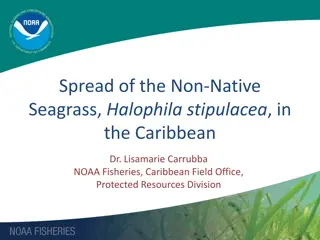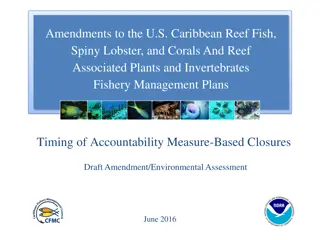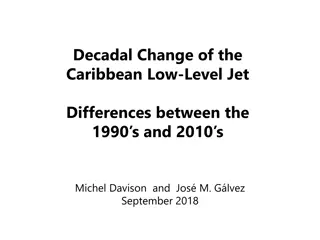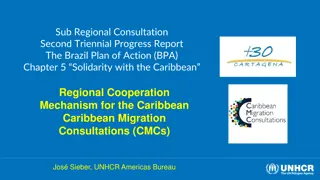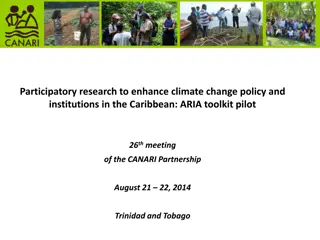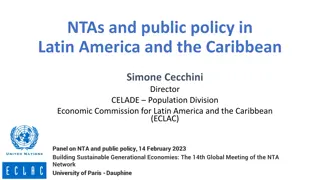Commercial Parrotfish Landings in the U.S. Caribbean
Analysis of commercial parrotfish landings in the U.S. Caribbean, focusing on regulations, ecological role, and future objectives. The data includes catch records, gear types, and key regulations to maintain stock sustainability.
Download Presentation

Please find below an Image/Link to download the presentation.
The content on the website is provided AS IS for your information and personal use only. It may not be sold, licensed, or shared on other websites without obtaining consent from the author.If you encounter any issues during the download, it is possible that the publisher has removed the file from their server.
You are allowed to download the files provided on this website for personal or commercial use, subject to the condition that they are used lawfully. All files are the property of their respective owners.
The content on the website is provided AS IS for your information and personal use only. It may not be sold, licensed, or shared on other websites without obtaining consent from the author.
E N D
Presentation Transcript
Analysis of Analysis of Commercial Parrotfish Commercial Parrotfish Landings in the U.S. Caribbean Landings in the U.S. Caribbean Southeast Regional Office St. Petersburg, Florida February 22, 2025
Parrotfish Herbivorous grazers removing algae which enhances settlement and survival of coral recruits (Brock 1979; Mumby 2006; Burkepile and Hay 2010). Ecological role of parrotfish has become more relevant in the past 30 years due to Caribbean-wide decline of longspine urchin (Mumby 2006). 2
U.S. Caribbean Parrotfish Regulations Caribbean Fishery Management Council (EEZ) Prohibition of Gill and Trammel Nets November 2005 Prohibition of Blue, Midnight, and Rainbow parrotfish In process USVI State Waters Prohibition of Gill and Trammel Nets July 2006 3
Magnuson-Stevens Reauthorization Act of 2006 set Annual Catch Limits (ACL) Parrotfish ACLs were calculated from the average landings generated from year sequences chosen by the Council Puerto Rico ACL similar to recent reported parrotfish landings St. Thomas/St. John ACL similar to recent reported parrotfish landings St. Croix ACL is 40% lower than average of recent reported parrotfish landings (2006-2008) 4
Parrotfish Regulations Objective 1. Future parrotfish landings will be at or below ACL levels 2. Satisfy fishermen s demands (i.e. ability to harvest plate sized parrotfish) 3. Maintain reproductive viability of the stock 5
Parrotfish Landings by Island Data: Commercial Catch Records 600,000 St. Thomas Puerto Rico St. Croix 500,000 400,000 Landings (lbs) 300,000 200,000 100,000 0 2000 2001 2002 2003 2004 Year 2005 2006 2007 2008 6
Parrotfish Landings by Gear Type Data: Commercial Catch Records for all 3 islands. Other Line Fishing Seines Trammel Net Gill Nets Traps 600,000 500,000 400,000 Landings (lbs) 300,000 200,000 100,000 0 2000 2001 2002 2003 2004 Year 2005 2006 2007 2008 7
Percentage of TIP records by parrotfish species for each island Numbers in parenthesize are sample size Princess 1.4 (87) 0.7 (7) 4.8 (116) Queen 0.2 (13) 0.2 (2) 4.8 (115) Redband 7.9 (463) 0.8 (8) 0.4 (9) Redfin 5.6 (329) 3.6 (38) 1.7 (42) Redtail 49.4 (2,907) 35.5 (2,090) 45.8 (485) 38.1 (923) Stoplight Striped 0.0 (0) 0.1 (1) 0.0 (0) St. Croix St. Thomas Puerto Rico 48.9 (518) 50.2 (1,213) All Three Islands 2.2(210) 1.4 (130) 5.1 (480) 4.4 (409) 46.1 (4,315) 40.8 (3,821) 0.01 (1) Data: Trip Interview Program Years of Data St. Croix 2008-2010 St. Thomas 2008-2010 Puerto Rico 2006-2008 8
20 18 16 Fork Length (in) 14 Male 12 10 9 Female 8 7 6 5 Princess Queen Redband Redfin Redtail Stoplight Data: Trip Interview Program Species Years of Data St. Croix 2008-2010 St. Thomas 2008-2010 Puerto Rico 2006-2008 Parrotfish are protogynous hermaphrodites (female to male) 9
Size Limit Analysis Example 1800 St. Croix TIP data: 2008-2010 1600 1400 Imposed Minimum Size Limit of 11 inches 1200 Frequency 1000 Removes 19% of landings 800 600 i.e. % Reduction = 19% 400 200 0 7 8 9 10 11 12 13 14 15 16 Fork Length (inches) 10
Size Limit Results Data: St. Croix TIP data for years 2008 to 2010 n is numbers of parrotfish, % RED is percent reduction Potential percent reductions are highlighted in green, extreme reductions are highlighted in yellow Minimum size N % RED 5,496 34 367 1,068 2,416 4,077 5,036 5,336 5,430 Size Limit (inches FL) No Limit 8 9 10 11 12 13 14 15 Maximum Size n 5,496 5,462 5,129 4,428 3,080 1,419 460 160 66 % RED 100 99.4 93.3 80.6 56.0 25.8 8.4 2.9 1.2 100 0.6 6.7 19.4 44.0 74.2 91.6 97.1 98.8 Percent reduction for each slot limit Maximum Size (inches FL) 11 56.6 26.4 62.7 32.5 75.4 45.2 - 69.8 Minimum Size (inches FL) 8 9 10 11 12 13 14 8 - 9 10 81.2 87.3 - 12 13 9.0 15.1 27.8 52.4 82.6 - 14 3.5 9.6 22.3 46.9 77.1 94.5 - 15 1.8 7.9 20.6 45.2 75.4 92.8 98.3 93.9 - - 11
Trip Limit Results for St. Croix Data: landings data for 2007 and 2008 Potential percent reductions are highlighted in green, extreme reductions are highlighted in yellow Trip Limits (lbs) No Harvest 10 20 30 40 50 60 70 80 90 100 150 200 300 400 500 Landings Reduction (lbs) 774,888 683,642 605,061 539,252 481,995 432,122 389,105 352,679 321,243 293,794 269,497 194,548 140,658 59,483 16,845 7,985 Percent Reduction 100 88.2 78.1 69.6 62.2 55.8 50.2 45.5 41.5 37.9 34.8 25.1 18.2 7.7 2.2 1.0 Toller (2007) determined a cut-off threshold of 162.5 pounds to separate net-scuba from scuba- only landings.
St. Croix percent reduction of landings from a combination of slot limits and trip limits Slot Limit (inches) Trip Limit (lbs) 10 90.2 88.5 92.0 20 81.9 78.7 85.1 30 74.8 70.4 79.4 40 68.7 63.2 74.3 50 63.4 56.9 70.0 100 46.0 36.5 55.7 150 38.0 27.0 49.1 200 32.3 20.3 44.5 8 to 12 8 to 14 10 to 14 13
Caveats Assuming previous year s landings are a reasonable predictor of future landings trends Trip limit reductions do not account for shifts in fishing effort or other behavior changes. 14
Regulation Impacts Minimum size limit: potentially allows fish to spawn before being harvested, but allows harvest of larger more fecund fish. Maximum Size Limit: protects larger more fecund fish, but allows harvest of smaller and possibly immature fish. Slot Limit: potentially protects both small immature and large fecund fish Bag limit: Can reduce illegal netting if set below 162 pounds. Also, contributes to landings reductions and allows more liberal slot limit 15
